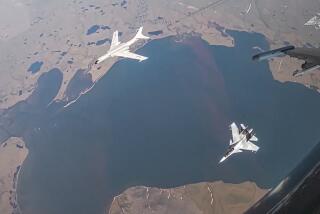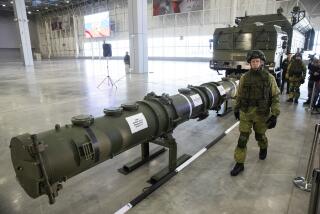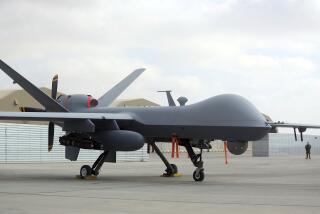Russia resumes regular flights of strategic bombers
MOSCOW — Russian President Vladimir V. Putin on Friday announced reinstatement of the Soviet-era practice of having nuclear bombers routinely make long-distance flights that bring them within striking distance of the United States and its allies.
“Today just after midnight, 14 strategic missile aircraft, with support and fuel planes, took off from seven airfields across Russia,” Putin said in televised remarks. “Combat duty began in which a total of 20 planes are taking part. From today, combat duty of this kind will be carried out on a regular basis.”
He expressed hope that the West would show “understanding” for his decision.
The White House sought to downplay the Russian action, saying that the resumption of flights did not indicate a worsening of relations or present a new strategic threat.
Putin’s announcement came at the end of a joint military exercise conducted by about 6,000 troops from Russia, China and four Central Asian states. Analysts said the exercise was meant to send a signal to the West that it should not try to interfere in the affairs of the participating countries.
The war games were observed by Putin, Chinese President Hu Jintao and other leaders of the six-member Shanghai Cooperation Organization, who held a summit in Kyrgyzstan on Thursday and then traveled to Russia’s Chebarkul training ground for the exercises.
The resumption of regular strategic bomber flights appeared aimed at influencing domestic and international politics rather than affecting the military balance of power. It also reflected Russia’s growing economic strength, with high oil prices boosting the country’s ability to spend money on its military. Routine bomber flights were discontinued in 1992.
“What we see today is not a step in the resumption of the Cold War but some kind of a Cold War farce staged by President Putin,” said Alexander Golts, a military analyst who writes for the Russian-language news website Yezhednevny Zhurnal.
“This would be a laughable farce but for one serious thing: It is a very dangerous farce. The strategic planes are up in the air. They may be carrying nuclear missiles or may not, which we will never know for sure, but this risk strongly exists.”
Putin said the bombers would fly primarily “in the regions of our busy sea routes and economic zones.” Russian strategic bombers can carry nuclear cruise missiles with ranges of at least 1,800 miles. He said that the bombers were scheduled to spend about 20 hours in the air Friday, and that they were being refueled in flight.
“We proceed from the notion that our partners will react with understanding to the resumption of flights of the Russian strategic air forces,” he said. “Our pilots have sat idle for too long. We have had a strategic air force but practically no flights.”
After a period of considerable warmth in the 1990s, U.S.-Russian relations have become increasingly strained in recent years. Washington has complained about what it sees as a rollback of democracy. U.S. dissatisfaction also has been fueled by Moscow’s alleged use of oil and gas export contracts to make political demands on its neighbors, a dispute over the future of Kosovo and other issues.
Russians have been angered by U.S. plans to install an antimissile system in Eastern Europe. Washington says it is needed to defend Europe and North America, citing the possibility of missile attacks by Iran. Moscow has expressed fear that the move would be a step toward a global missile-defense system aimed at devaluing Russia’s and China’s nuclear deterrents, and that the system could be modified for offensive missiles that would be close to Russia’s border.
However, Gordon Johndroe, a deputy White House spokesman, said the United States had “very good working relations” with the Russian government and armed forces. He portrayed the Russian move as a routine deployment or maneuvers, rather than an enhanced military posture.
Speaking in Texas, where the president is vacationing at his ranch near Crawford, Johndroe called the action “an internal decision made by the Russians” that did not come as a surprise. Asked whether the Pentagon considered the strategic bomber flights a threat, he responded, “Oh, I don’t think our military has those concerns about it.”
Golts said the resumption of bomber flights marked an effort by Putin to shift Moscow’s dialogue with the West toward strategic issues.
“Putin feels less and less comfortable being obliged to talk with his Western counterparts mostly about democracy and human rights,” Golts said. “He is fed up with this kind of dialogue, especially in conditions of uncertainty surrounding the 2008 presidential election in Russia.
“That is why he feels so inclined to return to the kind of dialogue his Soviet predecessors [Leonid I.] Brezhnev and [Mikhail S.] Gorbachev had with Presidents Ford and Reagan as equal players in a bilateral strategic game.”
James F. Collins, U.S. ambassador to Russia from 1997 to 2001, said Putin was “trying to make sure that nobody thinks he’s soft on national security in an election season.”
Collins, now director of the Russian and Eurasian program at the Carnegie Endowment for International Peace, noted that the move was part of a multilayered response by Putin to U.S. plans to install missile defense facilities in Eastern Europe.
On one hand, Collins said, Putin talks about cooperating with the West on missile defense, but on the other, he shows that Russia could respond militarily if it chose. In recent years, Putin has pushed to rebuild the Russian military, which deteriorated after the collapse of the Soviet Union.
The military drill in Chebarkul, 850 miles east of Moscow in the Ural Mountains, involved about 2,000 personnel from Russia, 1,700 from China, and others from Kazakhstan, Tajikistan, Kyrgyzstan and Uzbekistan.
The story line for the drill was that terrorists had taken over an area within one of the organization’s member states and that they must be captured or destroyed. The activities, however, looked more like practice in putting down a localized rebellion.
Television showed soldiers descending onto a rooftop from a helicopter, then rappelling down the side of the building. Others parachuted into the training ground. Artillery fired mortar rounds while the heads of state looked on with binoculars.
“Today’s exercise is another step in the strengthening of relations between all our states,” Putin said in televised remarks. “It is a step aimed at strengthening international peace, security and first of all the security of our peoples.”
Times staff writers Sergei L. Loiko in Moscow, Bob Drogin in Crawford and Maura Reynolds in Washington contributed to this report.
More to Read
Sign up for Essential California
The most important California stories and recommendations in your inbox every morning.
You may occasionally receive promotional content from the Los Angeles Times.










